Catocala nebulosa
kah-TOCK-uh-lah mm
neh-bew-LOH-suh
Edwards, 1864
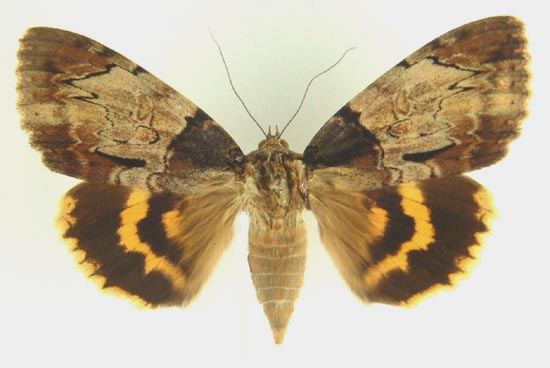
Catocala nebulosa female, Louisiana,
courtesy of Vernon A. Brou.
This site has been created by
Bill Oehlke at oehlkew@islandtelecom.com
Comments, suggestions and/or additional information are welcomed by Bill.
| TAXONOMY:
Superfamily: Noctuoidea
Family: Noctuidae
Group: Noctuinina
Subfamily: Catocalinae
Genus: Catocala, Schrank, 1802
| |
MIDI MUSIC
"Moon River"
copyright C. Odenkirk
MIDI CITYON.OFF
<bgsound src="moon.mid" LOOP=FOREVER>
|
DISTRIBUTION:
Catocala nebulosa, the Clouded Underwing,
(wingspan: 75-86mm) flies from southern Ontario south through
Tennessee, etc., to
Florida,
west to
Texas and eastern Oklahoma and north
to
Iowa, Michigan,
Wisconsin and
Minnesota (Tom Middagh)
It has also been reported in
Alabama,
Arkansas,
Connecticut,
Delaware,
District of Columbia,
Georgia,
Illinois,
Indiana,
Kansas,
Kentucky,
Louisiana,
Maryland,
Mississippi,
Missouri,
Nebraska,
New Jersey,
New York,
North Carolina,
Ohio,
Pennsylvania,
South Carolina,
South Dakota,
Virginia and
West Virginia.
Moths have a prominent dark brown upper-half-basal patch that extends to and ends
at the antemedial line. The apical area also tends to be brown, much
darker than the median area but not as dark as the basal patch.
The anal angle also has the darker brown scaling.
The pm line is distinct near the costa and inner margin, but becomes
weak in between. It meets the inner margin in relative close proximity to the am line.
The closed subreniform spot is large and connects to the
pm line via a thin line. Image courtesy of Marie Winn, New York.
| 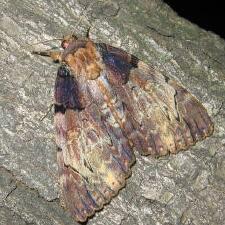 |
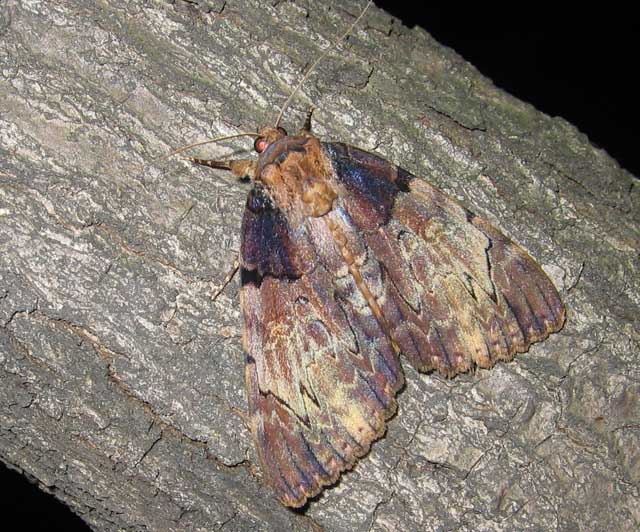
Catocala nebulosa, Central Park, New York courtesy of Marie Winn.
The hindwings show extensive brown scaling in the basal areas, almost
filling that area inside the black median band.
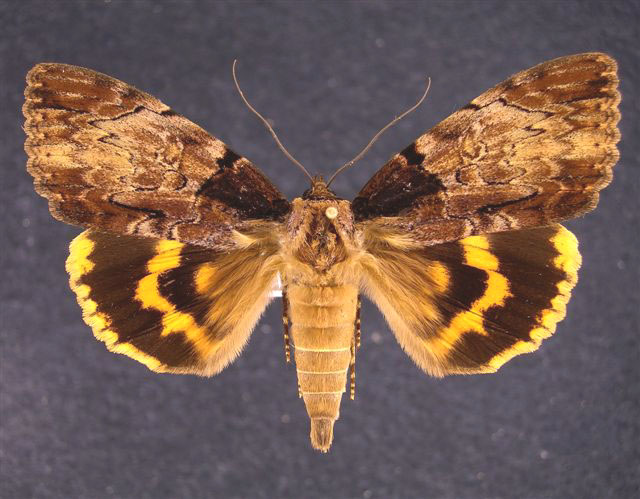
Catocala nebulosa, wingspan 80mm, courtesy of Jim Vargo.
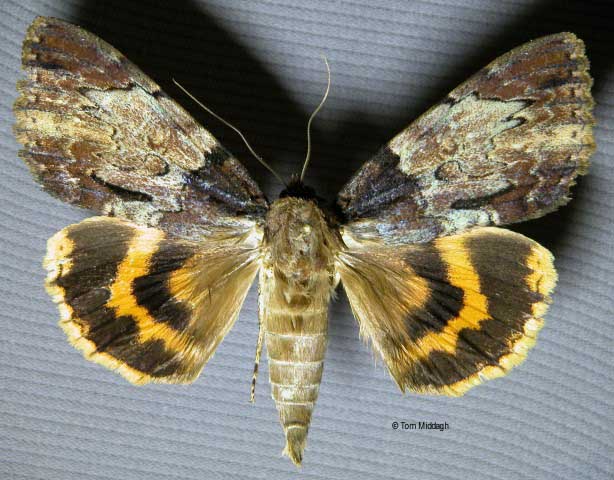
Catocala nebulosa, Worthington, Nobles County, Minnesota,
August 19, 2008, courtesy of Tom Middagh.
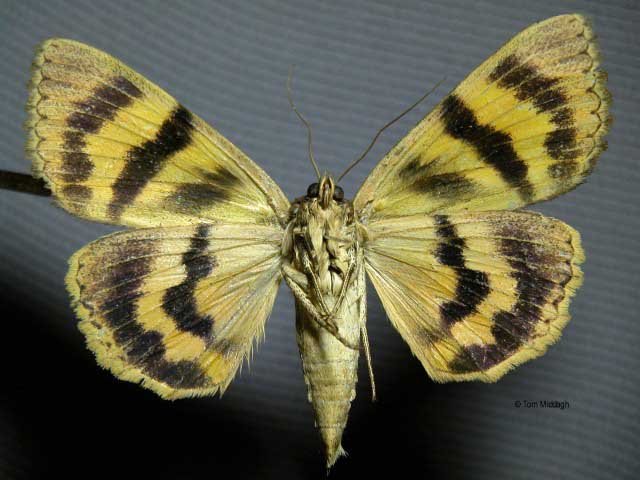
Catocala nebulosa (verso), Worthington, Nobles County, Minnesota,
August 19, 2008, courtesy of Tom Middagh.
Visit Catocala nebulosa (recto and verso), Mason, Ingham county, Michigan,
courtesy of Harry King.
Visit Catocala nebulosa, Burnet Park, LaSalle, Ontario, August 13, 2009,
courtesy of Maurice Bottos.
Visit Catocala nebulosa live, Abingdon, Harford County, Maryland,
September 12, 2009, courtesy of Kevin Harkins.
FLIGHT TIMES AND PREFERRED FOOD PLANTS:
Catocala nebulosa are on the wing from late July to September.
The Catocala nebulosa caterpillar feeds on Carya cordiformis and Juglans nigra.
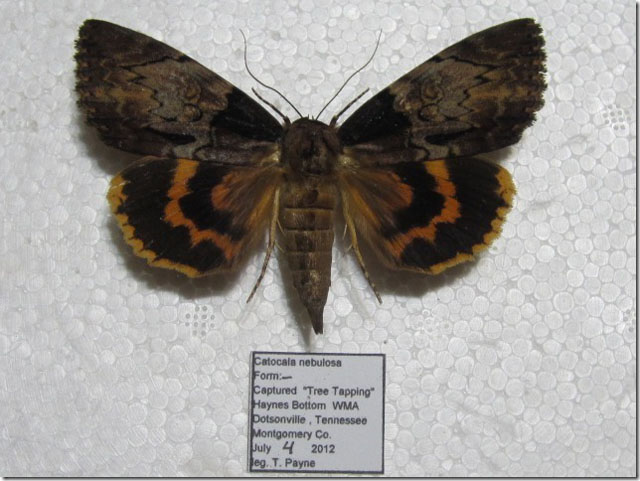
Catocala nebulosa, Haynes Bottom WMA, Dotsonville, Montgomery County, Tennessee,
July 4, 2012, courtesy of Thomas Payne.
ECLOSION:
Adults eclose from pupae at soil surface.
SCENTING AND MATING:
Catocala nebulosa females
emit an airbourne pheromone and males use their antennae to track the
scent plume.
EGGS, CATERPILLARS, COCOONS, AND PUPAE:
Eggs are deposited on
tree bark in the fall and hatch the following spring.
Larval Food Plants
Listed below are primary food plant(s) and alternate food plants.
It is hoped that this alphabetical listing followed by the common
name of the foodplant will prove useful. The list is not exhaustive,
although some species seem very host specific.
Experimenting with closely related foodplants is worthwhile.
Carya cordiformis.....
Juglans nigra
|
Bitternut hickory
Black walnut
|
This page is brought to you by Bill Oehlke and the
WLSS. Pages are on space rented from Bizland. If you would like to become a "Patron of the Sphingidae/Catocala Sites",
contact Bill.
Please send sightings/images to Bill. I will do my best to respond to requests for identification help.
Enjoy one of nature's wonderments: Live Saturniidae (Giant Silkmoth) cocoons.

|

To show appreciation for this site, click on the flashing
butterfly to the left, a link
to many worldwide insect sites. |








